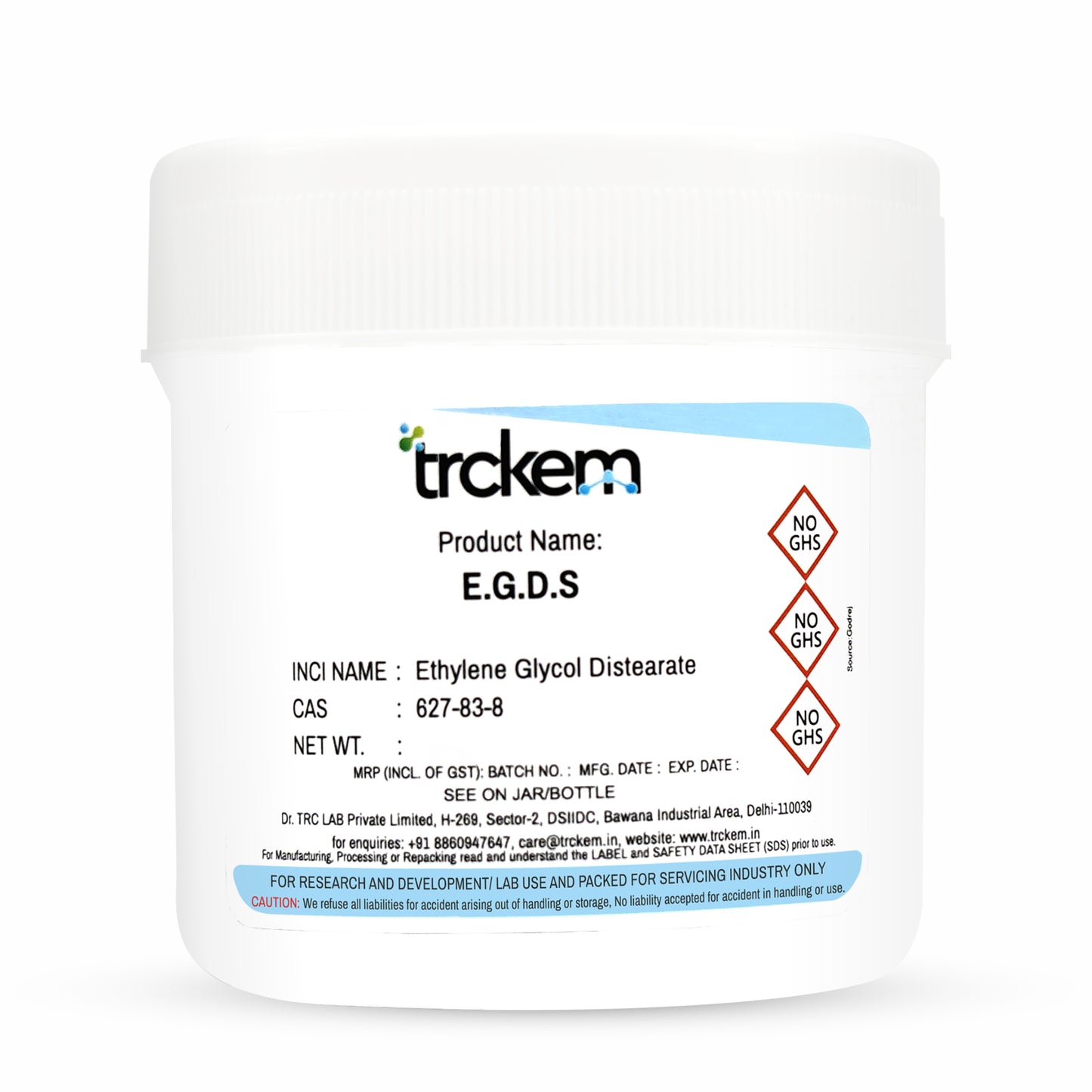




THE STORY OF ETHYLENE GLYCOL DISTEARATE (EGDS)

EGDS: The Pearlizing Agent that Adds Shine, Smoothness & Luxury
EGDS (Ethylene Glycol Distearate) is a pearlizing and opacifying agent used in shampoos, body washes, and cleansers to create a creamy, luxurious, pearlescent appearance.
It also acts as a skin-conditioning emollient, improving texture, smoothness, and viscosity in surfactant-based systems.

A Stearic Acid Ester Crafted for Aesthetic Enhancement
EGDS is produced through the esterification of:
• Ethylene glycol
• Stearic acid (vegetable-derived fatty acid)
The result is a waxy, white crystalline solid known for creating shimmering pearl effects in liquid cleansers.
TRCkem supplies high-purity cosmetic-grade EGDS with excellent dispersibility in surfactant systems.

Pearlize. Condition. Beautify.
EGDS delivers multiple formulation benefits:
✅ Creates creamy pearlescent shine in surfactant formulas
✅ Improves texture, thickness, and visual appeal
✅ Adds light emolliency for smoother skin feel
✅ Enhances long-term stability of cleanser systems
Used in: shampoos, body washes, face cleansers, moisturizing shower gels, and baby bath products.

Easy-to-Use, Stable & Ideal for Surfactant Systems
• Typical use level: 0.5–3%
• Melt EGDS into the heated surfactant phase (60–70°C)
• Pearl effect fully develops when the formula cools
• Compatible with SLES, SLS, Betaine, Glucosides & most surfactants
• Safe, non-irritating, and biodegradable fatty ester
• Store in cool, dry conditions away from moisture
• Approved globally for cosmetic applications
Formulator’s Queries, We Answered
1. What is Ethylene Glycol Distearate (E.G.D.S.)?
Ethylene Glycol Distearate (E.G.D.S.) is a pearlescent opacifier and emulsifying agent widely used in personal care and cosmetic formulations. It enhances the visual appeal of products by providing a shimmering, pearly effect while also improving texture and consistency.
2. What is the INCI Name of Ethylene Glycol Distearate?
The INCI (International Nomenclature of Cosmetic Ingredients) name for E.G.D.S. is Ethylene Glycol Distearate.
3. What is the CAS Number of Ethylene Glycol Distearate?
The CAS (Chemical Abstracts Service) number for Ethylene Glycol Distearate is 627-83-8.
4. What are the key benefits of Ethylene Glycol Distearate in personal care products?
Provides a luxurious pearlescent effect to formulations.
Acts as an emulsifier, helping to stabilize products.
Enhances product viscosity and texture.
Improves the spreadability and feel of personal care products.
Compatible with sulfate-free and mild formulations.
5. In which personal care products is Ethylene Glycol Distearate used?
E.G.D.S. is commonly found in:
Shampoos and conditioners
Body washes and liquid soaps
Facial cleansers
Creams and lotions
Bath gels and exfoliants
6. Is Ethylene Glycol Distearate safe for skin and hair care applications?
Yes, E.G.D.S. is generally recognized as safe for cosmetic and personal care applications. It is non-irritating and suitable for most skin types when used within recommended levels.
7. Is Ethylene Glycol Distearate eco-friendly?
E.G.D.S. is biodegradable and derived from natural fatty acids, making it an environmentally friendly choice for sustainable formulations.
8. Can Ethylene Glycol Distearate be used in sulfate-free formulations?
Yes, E.G.D.S. is compatible with sulfate-free formulations, helping to improve texture and enhance the appearance of the final product.
9. Where can I purchase Ethylene Glycol Distearate for personal care formulations?
E.G.D.S. is available from specialty chemical suppliers, cosmetic raw material distributors, and bulk manufacturers catering to the personal care industry.
10. What is the recommended usage level of Ethylene Glycol Distearate in formulations?
The typical usage level of E.G.D.S. ranges between 1% and 5%, depending on the desired texture, pearlescent effect, and formulation type. It is advisable to conduct formulation testing to achieve the best results.







